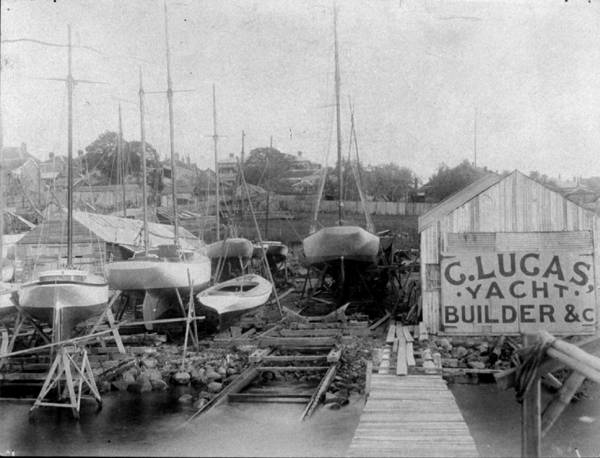 |
 |
|
Shipbuilding
Shipbuilding has been a significant industrial activity since the early colonial period, although it has gone through many periods of boom and bust. It flourished through the need for vessels to carry the greater part of commerce around the coast, interstate and overseas, as well as from the abundance of local timbers such as blue gum for constructing seagoing vessels, and celery-top and Huon pine for smaller craft. Although the greater number of vessels have been built between Hobart and the Huon River in southern Tasmania, most parts of the state's coast have seen shipbuilding activity. The first locally built seagoing vessels were the 40-ton schooner Henrietta Packet and 133-ton brig Campbell Macquarie, in 1813. By the late 1820s shipbuilding was a significant industry and, despite a hiatus during the depression of the early 1840s, the period up to 1850 experienced a boom. The largest vessels built during this period were the 563-ton ship Tasman built at Hobart by her owner Henry Degraves in 1847, and the 547-ton ship Harpley built on the Tamar River the same year. Government shipyards at Macquarie Harbour and Port Arthur also supplied many vessels, from small boats up to a substantial river steamer and seagoing schooners, brigs and a barque, for both government use and commercial sale. An influx of cheap shipping following the Victorian gold rush greatly reduced local shipbuilding until an extensive trade in locally built coastal vessels to intercolonial owners sparked a revival in the 1860s. This led to a number of moderately large seagoing sailing ships being built, the most famous being the locally owned barque Harriet McGregor for the Hobart–London trade in 1871. Without an extensive local metal industry, shipbuilders were poorly equipped to take advantage of iron shipbuilding, and only one iron vessel, the steam dredge Agnew in 1887, was ever built in Tasmania. Shipbuilding after the 1880s was limited to coastal and interstate sailing vessels, and small river and coastal steamers fitted with (mostly) imported engines. Prominent yards during the early 1900s were Purdon and Featherstone at Hobart, Wilson Brothers on the Huon River, EA Jack at Launceston and Harry Wood at Devonport. Both world wars saw flurries of shipbuilding activity, seagoing sailing vessels being built in Hobart after the first, and wooden motor vessels up to 35 metres in length for military use during the second. Neither boom was sustained after the war, although the growth in both leisure and fishing since the 1950s has supported an extensive industry engaged in traditional wooden boat building, employing many hundreds of people around the state. By the 1970s welded steel tugs, fishing vessels and ferries were being built in yards all around the state, and continue to be. During the late 1970s Hobart ferry operator Robert Clifford established a yard to build fast catamaran ferries. From modest beginnings, his International Catamarans (Incat) has grown to be Tasmania's most successful ever shipbuilder, having constructed to date 60 vessels ranging up to 5000 gross ton super for the overseas market. Other major shipbuilders include North West Bay Ships (Margate) and Richardson Devine (Hobart). Further reading: H O'May, Wooden hookers of Hobart Town, Hobart, 1978; and Hobart river craft, Hobart, 1959; G Broxam, Those that survive, Canberra, 1996. Graeme Broxam |
Copyright 2006, Centre for Tasmanian Historical Studies |
